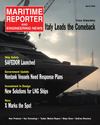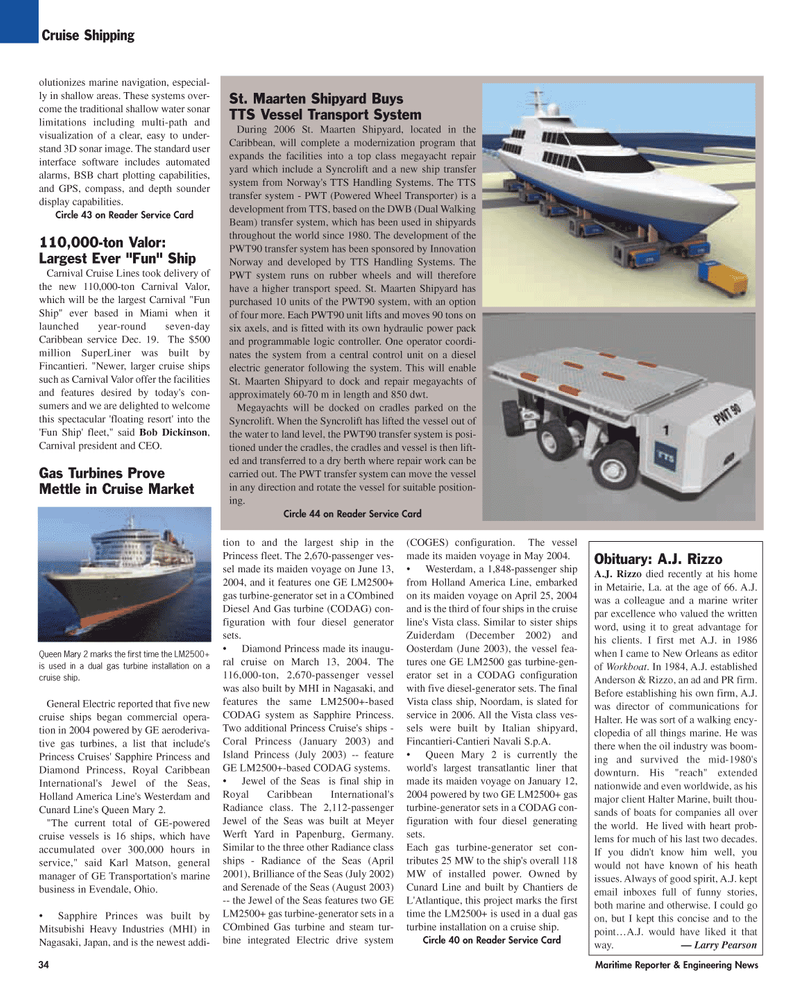
Page 34: of Maritime Reporter Magazine (March 2, 2005)
Read this page in Pdf, Flash or Html5 edition of March 2, 2005 Maritime Reporter Magazine
olutionizes marine navigation, especial- ly in shallow areas. These systems over- come the traditional shallow water sonar limitations including multi-path and visualization of a clear, easy to under- stand 3D sonar image. The standard user interface software includes automated alarms, BSB chart plotting capabilities, and GPS, compass, and depth sounder display capabilities.
Circle 43 on Reader Service Card 110,000-ton Valor:
Largest Ever "Fun" Ship
Carnival Cruise Lines took delivery of the new 110,000-ton Carnival Valor, which will be the largest Carnival "Fun
Ship" ever based in Miami when it launched year-round seven-day
Caribbean service Dec. 19. The $500 million SuperLiner was built by
Fincantieri. "Newer, larger cruise ships such as Carnival Valor offer the facilities and features desired by today's con- sumers and we are delighted to welcome this spectacular 'floating resort' into the 'Fun Ship' fleet," said Bob Dickinson,
Carnival president and CEO.
Gas Turbines Prove
Mettle in Cruise Market
Queen Mary 2 marks the first time the LM2500+ is used in a dual gas turbine installation on a cruise ship.
General Electric reported that five new cruise ships began commercial opera- tion in 2004 powered by GE aeroderiva- tive gas turbines, a list that include's
Princess Cruises' Sapphire Princess and
Diamond Princess, Royal Caribbean
International's Jewel of the Seas,
Holland America Line's Westerdam and
Cunard Line's Queen Mary 2. "The current total of GE-powered cruise vessels is 16 ships, which have accumulated over 300,000 hours in service," said Karl Matson, general manager of GE Transportation's marine business in Evendale, Ohio. • Sapphire Princes was built by
Mitsubishi Heavy Industries (MHI) in
Nagasaki, Japan, and is the newest addi- tion to and the largest ship in the
Princess fleet. The 2,670-passenger ves- sel made its maiden voyage on June 13, 2004, and it features one GE LM2500+ gas turbine-generator set in a COmbined
Diesel And Gas turbine (CODAG) con- figuration with four diesel generator sets. Diamond Princess made its inaugu- ral cruise on March 13, 2004. The 116,000-ton, 2,670-passenger vessel was also built by MHI in Nagasaki, and features the same LM2500+-based
CODAG system as Sapphire Princess.
Two additional Princess Cruise's ships -
Coral Princess (January 2003) and
Island Princess (July 2003) -- feature
GE LM2500+-based CODAG systems. Jewel of the Seas is final ship in
Royal Caribbean International's
Radiance class. The 2,112-passenger
Jewel of the Seas was built at Meyer
Werft Yard in Papenburg, Germany.
Similar to the three other Radiance class ships - Radiance of the Seas (April 2001), Brilliance of the Seas (July 2002) and Serenade of the Seas (August 2003) -- the Jewel of the Seas features two GE
LM2500+ gas turbine-generator sets in a
COmbined Gas turbine and steam tur- bine integrated Electric drive system (COGES) configuration. The vessel made its maiden voyage in May 2004. Westerdam, a 1,848-passenger ship from Holland America Line, embarked on its maiden voyage on April 25, 2004 and is the third of four ships in the cruise line's Vista class. Similar to sister ships
Zuiderdam (December 2002) and
Oosterdam (June 2003), the vessel fea- tures one GE LM2500 gas turbine-gen- erator set in a CODAG configuration with five diesel-generator sets. The final
Vista class ship, Noordam, is slated for service in 2006. All the Vista class ves- sels were built by Italian shipyard,
Fincantieri-Cantieri Navali S.p.A. Queen Mary 2 is currently the world's largest transatlantic liner that made its maiden voyage on January 12, 2004 powered by two GE LM2500+ gas turbine-generator sets in a CODAG con- figuration with four diesel generating sets.
Each gas turbine-generator set con- tributes 25 MW to the ship's overall 118
MW of installed power. Owned by
Cunard Line and built by Chantiers de
L'Atlantique, this project marks the first time the LM2500+ is used in a dual gas turbine installation on a cruise ship.
Circle 40 on Reader Service Card
St. Maarten Shipyard Buys
TTS Vessel Transport System
During 2006 St. Maarten Shipyard, located in the
Caribbean, will complete a modernization program that expands the facilities into a top class megayacht repair yard which include a Syncrolift and a new ship transfer system from Norway's TTS Handling Systems. The TTS transfer system - PWT (Powered Wheel Transporter) is a development from TTS, based on the DWB (Dual Walking
Beam) transfer system, which has been used in shipyards throughout the world since 1980. The development of the
PWT90 transfer system has been sponsored by Innovation
Norway and developed by TTS Handling Systems. The
PWT system runs on rubber wheels and will therefore have a higher transport speed. St. Maarten Shipyard has purchased 10 units of the PWT90 system, with an option of four more. Each PWT90 unit lifts and moves 90 tons on six axels, and is fitted with its own hydraulic power pack and programmable logic controller. One operator coordi- nates the system from a central control unit on a diesel electric generator following the system. This will enable
St. Maarten Shipyard to dock and repair megayachts of approximately 60-70 m in length and 850 dwt.
Megayachts will be docked on cradles parked on the
Syncrolift. When the Syncrolift has lifted the vessel out of the water to land level, the PWT90 transfer system is posi- tioned under the cradles, the cradles and vessel is then lift- ed and transferred to a dry berth where repair work can be carried out. The PWT transfer system can move the vessel in any direction and rotate the vessel for suitable position- ing.
Circle 44 on Reader Service Card 34 Maritime Reporter & Engineering News
Cruise Shipping
Obituary: A.J. Rizzo
A.J. Rizzo died recently at his home in Metairie, La. at the age of 66. A.J. was a colleague and a marine writer par excellence who valued the written word, using it to great advantage for his clients. I first met A.J. in 1986 when I came to New Orleans as editor of Workboat. In 1984, A.J. established
Anderson & Rizzo, an ad and PR firm.
Before establishing his own firm, A.J. was director of communications for
Halter. He was sort of a walking ency- clopedia of all things marine. He was there when the oil industry was boom- ing and survived the mid-1980's downturn. His "reach" extended nationwide and even worldwide, as his major client Halter Marine, built thou- sands of boats for companies all over the world. He lived with heart prob- lems for much of his last two decades.
If you didn't know him well, you would not have known of his heath issues. Always of good spirit, A.J. kept email inboxes full of funny stories, both marine and otherwise. I could go on, but I kept this concise and to the point…A.J. would have liked it that way. — Larry Pearson
MR MARCH 2005 #5 (33-40).qxd 3/1/2005 2:12 PM Page 2

 33
33

 35
35
